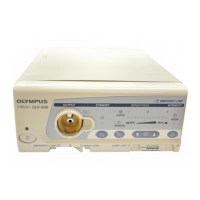50
Chapter 5 Operation
VISERA XENON LIGHT SOURCE CLV-S40
Chapter 5 Operation
The operator of this instrument must be a physician or medical personnel under
the supervision of a physician and must have received sufficient training in
clinical endoscopic technique. This manual, therefore, does not explain or
discuss clinical endoscopic procedures. It only describes basic operation and
precautions related to the operation of this instrument.
• Wear personal protective equipment to guard against
dangerous chemicals and potentially infectious material.
During operation, wear appropriate personal protective
equipment, such as eye wear, face mask, moisture-resistant
clothing and chemical-resistant gloves that fit properly and
are long enough so that your skin is not exposed.
• Anytime you suspect an abnormality in a light source
function, stop using the equipment immediately and take
action according to the following procedures. Using a
defective light source may cause damage to the patient’s
health. In addition, be sure to prepare another light source to
avoid that the examination must be interrupted due to
equipment failure or malfunction.
After withdrawing the endoscope from the patient, take
proper measures as described in Section 8.1,
“Troubleshooting guide”. If an abnormality is still suspected,
stop using the instrument on patients again and contact
Olympus as described in Section 8.2, “Returning the light
source for repair”.
− If the image on the monitor becomes white or black when
the automatic brightness control is selected, the
automatic brightness control may be malfunctioning. In
this event, select “MANUAL” mode and adjust the
brightness properly. Connect the endoscope to the
prepared another light source, after treatment to secure a
safety of the patient.
− If the illumination lamp fails, move the emergency lamp
switch lever to the emergency lamp position. Connect the
endoscope to another prepared light source, after
treatment to secure a safety of the patient.
The emergency lamp provides only the bare minimum of
light needed to keep operating in an emergency, so it is
not recommended for use during a procedure.

